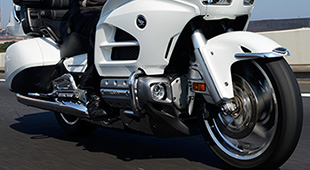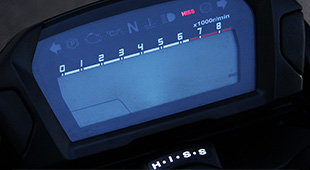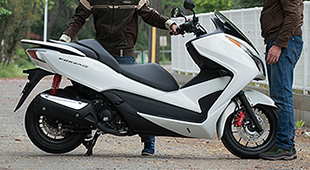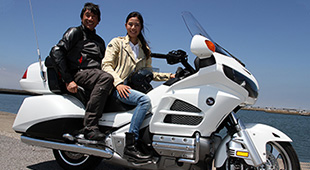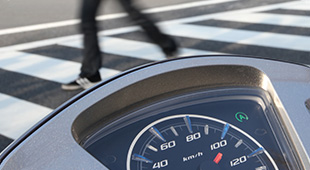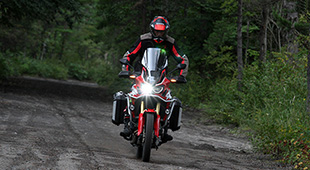Tech Views — Vol. 9 G Switch and Selectable Torque Control
Impressions (3/3)
Dirt Slope Start — Test 1
Selectable Torque Control: Default (Level 3)
G Switch: Default (OFF)
Throttle under acceleration: Gradual to 10%
Leaving the Selectable Torque Control in its default position (Level 3), I gradually opened the throttle to 10 percent from dead stop on the wet dirt slope. The Selectable Torque Control intervened immediately as I started to move. Its intervention was similar to that experienced on the Gravel Road Acceleration test; the torque control continuing to work as speed increased. The Africa Twin took off as if nothing unusual was happening. I felt it smoothly start to move and power up the slope without any hint of rear wheel slip or skidding sideways.
Dirt Slope Start — Test 2
Selectable Torque Control: OFF
G Switch: Default (OFF)
Throttle under acceleration: Gradual to 10%
It was only when I attempted the slope start with the Selectable Torque Control switched OFF that I came to realize how truly effective it is. Throttle opening was almost identical to my first Dirt Slope Start test. However, contrary to my experience accelerating on the flat road, as the rear wheel tried to push the bike up the slope it began slipping almost from the instant power was applied. Unless the bike was perfectly vertical, it instantly wanted to slip sideways. When starting from a standing stop, the loss of drive force to sideways motion was causing climbing power and speed to drop off considerably.
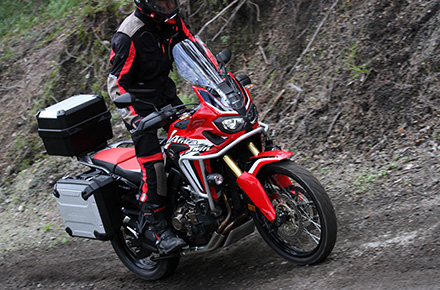
I started slipping into a downward spiral as the bike’s instability made it difficult to open the throttle, and when opened the rear tire slid more. To prevent this, the rider needs to adjust by accurately shifting body weight. This may be part of the fun of off-road control, but when attempting a slope start in these conditions, it would be preferable to move the bike to a safer location that offers less risk. I thought the difference was a result of a less than expected throttle opening. The incline of the slope was similar to what one might encounter on a typical forest trail.
Dirt Slope Start — Test 3
Selectable Torque Control: Default (Level 3)
G Switch: Default (OFF)
Throttle under acceleration: Rapid to 50%
The answers I was looking for seemed to have been revealed by the differences I’d already experienced in Dirt Slope Start Tests 1 and 2, but I still carried out a similar set of tests based on a 50% throttle opening.
Starting out on the slope with the Selectable Torque Control switched to its default setting (Level 3), I cranked open the throttle and began my run. As I experienced at the start of my gravel road acceleration test, the torque control accurately suppressed any rear wheel slippage and instantly attenuated acceleration after the start. However, since the acceleration was quick, I needed to be sensitive lest my body should be slow in raising my left foot to the step from its place on the ground and in reacting to this short burst of strong acceleration. I wondered if the rear wheel would start slipping if the bike started to lean and got a bit anxious. Although I might have been somewhat overanxious when the wheel slipped slightly, it didn’t get worse than that. I finished climbing the hill with the rear wheel swinging out a bit. Though it was just a test, it might have been a bit rash to crank open the Africa Twin’s throttle to 50% in this situation.
Dirt Slope Start — Test 4
Selectable Torque Control: OFF
G Switch: Default (OFF)
Throttle under acceleration: Rapid to 50%
In this last run, I executed my slope start with the Selectable Torque Control switched OFF and quickly opened the throttle to 50 percent. To see what happened, it might be best to watch the video. Before I could raise my foot to the step, the rear wheel suddenly skidded off to the right and I quickly had to counter both the bike’s lean and its trajectory. Then, the bike slid over to the other side in reaction, and quickly back again. Obviously, the bike didn’t climb the slope very smoothly or straight this time.
Though at a glance it might appear that I was using some special off-road technique to keep it all under control, this extreme sort of riding is seldom ever required off the test course. It was pretty obvious that the engine’s power was way too much for these conditions. What if the bike had fallen, out of control and flipping over as a result of having yanked open the throttle in such a way? Merely standing the bike back up on its wheels required considerable physical strength, and if I got injured, well, that would have been too bad. There always lurks the possibility that even an easy and enjoyable ride can turn quickly into a bitter memory of total exhaustion.
Completing the Test
In conclusion, riders who really push their bikes can watch the video and clearly understand the visible differences in performance, and the effectiveness of the Selectable Torque Control. The tests this time were repetitive, and each time I ran one more was learned and my body began to subconsciously anticipate the bike’s movements. Therefore, I can look back on these tests as the experience of a phenomena that was based on a certain degree of predictability.
In the case of a touring rider encountering a road surface for the first time that doesn’t appear to be slippery but in fact is, or other cases where a rider can’t cope quickly enough, these situations must also be considered. It is not uncommon for even familiar well-traveled roads to change drastically as surface conditions are affected by the season or the weather.
While performing the dirt slope start test, I found myself focusing on thoughts like, “That’s fine. Now let’s think of a seating position that positions the body upright for a better application of rear wheel driving force.” This, I thought, was a new form of riding enjoyment that the Selectable Torque Control made possible. I also found it enjoyable to ride aggressively while spectacularly sliding the rear wheel and correcting it. However, the thinking above gets to the very essence of riding as much as any wild riding stunts. Above all else, riding is an exercise in survival, and those who manage not to fall are the real winners.
Another thing I want to emphasize again here is that these devices go a long way toward further expanding one’s riding pleasure relative to one’s riding abilities. When I tried using my right hand to open the throttle in various ways in an attempt to extract more drive force, I found a new range of depth there.
The joys of riding, in which depth and flavor change depending on one’s level of skill, also exists today when dependable and objective rider supports like the G Switch and Selectable Torque Control are combined. Receiving this combination of assistance is truly a great benefit.
What I found most impressive in my testing was that if both the G Switch and the Selectable Torque Control are used efficiently, and my own bike and skills are tuned to road conditions, the overall pleasure of riding is greatly enhanced. This, of course, should be based on the high performance of the Africa Twin’s basic package, and also on the fact that the DCT succeeds in expanding the pleasure of off-road riding. However, the existence of Selectable Torque Control, which fits in as an additional device, gives great advantages in equal measure to both those who love off-road riding and those who’ve never had any interest in riding off-road before.
Additionally, I really felt that the G Switch is a pleasant piece of equipment for those who want to further deepen their off-road riding enjoyment. It makes anyone feel like they can really go wherever they want. Yes, this bike will always have a “reliable companion” onboard.
“Well, let’s start our new journey,” the Africa Twin seems to beckon.

